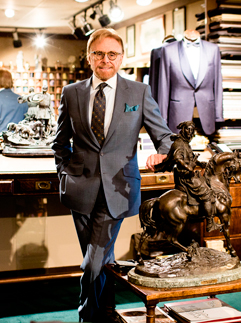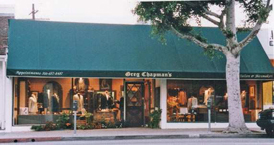 Your clothing is a projection of who you are, what you do, and how well you do it. It tells people your degree of success in your field. The way we speak, our vocabulary, the way we present ourselves, the things we choose to talk about, and the way we dress, all reveal where we rank in the social hierarchy. Here’s the good news: We can change how we’re perceived and received almost overnight, by changing the first thing people see—our clothes.
Your clothing is a projection of who you are, what you do, and how well you do it. It tells people your degree of success in your field. The way we speak, our vocabulary, the way we present ourselves, the things we choose to talk about, and the way we dress, all reveal where we rank in the social hierarchy. Here’s the good news: We can change how we’re perceived and received almost overnight, by changing the first thing people see—our clothes.
The thing that takes wardrobes to a new level more than anything else, believe it or not, is…the way clothes fit. A model in a cheap suit can look better than an odd-size person in a very expensive suit that doesn’t fit. Most suits look better on the hanger than on the people who purchase them.
The right wardrobe can change your life. We see countless examples of our clothing making a huge difference. One relatively new client of mine raises private capital for wealth management. He went from raising $20 million his first year to $25 million his second year, and from $30 million the year he met us to $310 million the year he began to wear our clothing. He maintains that from the first day, there was a dramatic difference in the way he was received. People made decisions within hours or days, rather than taking six months to “think about it.”
Most people, particularly men, tend to buy new clothes only under pressure. Typically they will buy two or three suits at the same time and continue wearing them until they get worn out from dry cleaning. They then go out and buy three replacements suits and repeat the process.
Over a 40-year career, they end up spending about $60,000 on suits but never have more than three to wear at any given time. If they were to spend three to five years building a “core wardrobe” of classic, well-made, properly-fitting suits, they would have an investment wardrobe that would serve them well throughout their career.
According to the Wool Bureau, good quality pure wool has a memory and it takes four to six weeks for a suit to recover. So, if one has enough clothing to wear something no more than once a month (20 to 30 changes), a suit will never wear out, theoretically, because it will not have to be dry cleaned, which is what kills the suit. But there’s another element that we haven’t discussed. Ninety-five percent of today’s clothing is put together quickly and inexpensively through a process known as “fusing.” Forty years ago suits were made with a canvas interlining (called a hymo canvas). Varying degrees of handwork would make for a good suit with a hymo, BY GREG CHAPMAN FEBRUARY/MARCH 2007 CELEBSTAFF 75 or a cheap suit, with a hymo front.
The typical “breakpoint” in the stores where fused suits stop and canvas hymo front suits start, is from $1800 to $2000. For a little more you can have a custom made suit that will still look good 25 years later.
 The key to building a wardrobe is to view the process of being well dressed as just that—a process. By adding new clothing to your wardrobe at periodic intervals you begin to put “time” to work for you, much like putting money away for your children’s college or funding your retirement program.
The key to building a wardrobe is to view the process of being well dressed as just that—a process. By adding new clothing to your wardrobe at periodic intervals you begin to put “time” to work for you, much like putting money away for your children’s college or funding your retirement program.
Thirty years ago I devised the Wardrobe Plan Program. Many hundreds of my clients have built amazing wardrobes with this simple concept. “Time,” which is usually the enemy, racing forward, making things obsolete or worn out, suddenly becomes the key to force-feeding your wardrobe with regular additions arriving on a schedule. Whether you call on us to make your clothes, or you set up a dedicated account funding it with so much each month, you’ll see a miracle happen.
Start with solid fabrics that can be broken up and worn as separates. There are many advantages to buying custom-made clothes, one of which is that you can purchase a navy blazer and the slacks of the same fabric, which allows you to wear it as both a blazer and a suit. Add tan, grey, and charcoal slacks and you’ve got four outfits revolving around one jacket. The next item for your wardrobe might be a suit that could mix and match with the blazer and navy solid slacks; it might be a grey and blue muted plaid, a houndstooth or tweed, or a textured fabric that could be worn as a jacket with the navy slacks, or as slacks with the navy blazer. If the accent colors in the plaid or houndstooth permit, you might wear it with the grey, charcoal, and/or tan slacks as well.
Now, with the two suits and two or three extra slacks, you have seven or eight different outfits, which are already getting you through nearly two weeks without repeating the same outfit. By taking the strain off the same pants worn every week, you’re allowing them to “recover” with the wrinkles falling out without cleaning. Now, by adding another outfit in three or four months, you might even get another mix and match outfit out of the navy blazer suit. Perhaps those medium-grey solid slacks had a matching jacket that could look as good with the navy slacks, as it does as with a medium-grey suit. Depending on your best colors, the same concept can revolve around a black blazer suit, or dark brown, deep olive, tan solid, taupe, teal, royal navy, rust, or virtually any color. Start with the family of colors that accent your hair color or your eyes. That’s a great start. Then build on it. The efficiency of staying within limited colors to start will allow you to wear the same six to 12 shirts with virtually every outfit. Fewer shoes, belts, and ties all can offset the expense of buying more expensive, better made, even custom-made clothing. As styles change, since the fabrics are ageless, you might do a little restyling, and well-made clothes, particularly custom, can be let out from three to five inches, when all the seams and darts are opened; this can extend the life of a good suit an extra ten years, if you change weight, or consider styles that require changing the “silhouette” of the suit.
 Classic, well-made clothing, made of high-quality fabrics, can serve you well for 20 to 30 years, looking like clothes that you just purchased. View your clothing budget as a PR and advertising expense. You are your business. You might leave your car around the block, but your clothes go with you into every encounter and should be your first consideration.
Classic, well-made clothing, made of high-quality fabrics, can serve you well for 20 to 30 years, looking like clothes that you just purchased. View your clothing budget as a PR and advertising expense. You are your business. You might leave your car around the block, but your clothes go with you into every encounter and should be your first consideration.

